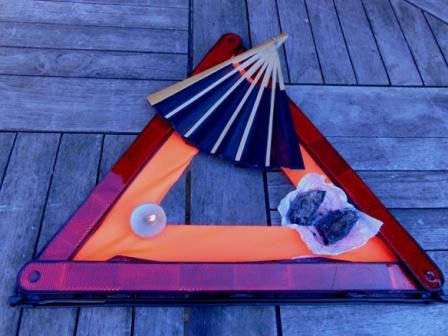 To make fire you need in an appropriate ratio three things : oxygen, heat, fuel.
To make fire you need in an appropriate ratio three things : oxygen, heat, fuel.
Once burning (rapid oxidation) is engaged, the fire will heat the surrounding material and gasificate it. These gases keep the fire burning.
Also to maintain the fire you need those three factors. One hat block burns hardly, two or more logs (close) together keep the fire burn better.
Small fragments burn better because air (oxygen) can enter easier. Blowing or waving, or bellows can help there too.
To create a fire the smallest particles that allow much air circulation are the most suitable. If you only can make a spark with great difficulty, it is extremely important to have good tinder. You cannot afford to fool around with wet or too thick splinters. It is wise to have some dry tinder in stock. You can split damp wood, the inside is often obviously much drier than the outside.
The fire should also be build carefully. Very little material on the bottom, and little bigger parts above, without the larger can stifle the small. Make it a small pyramid.
Hard wood burns longer and slower than softer wood.
In 1816, J.W. Dobereiner made the first lighter (the Dobereiner lamp) with a hydrogen cartridge (!) and a platinum catalyst. The phosphorus lucifer was only invented in 1827. And the Zippo lighter in 1930.
A liquid itself does not burn. A heat source ensures that in liquids and solids gases are released. They ignite and burn as a certain energy (inflammation) is added. The lowest temperature at which such ignitable gases release is the flash point.
|
methane |
- 188°C |
alcohol |
+12°C (methanol : 11°C) |
|
ether |
- 45°C |
white spirit |
+ 35°C |
|
petrol |
- 23°C |
diesel |
+ 50°C |
The temperature at which the product will ignite spontaneously is called the ignition temperature of self-ignition temperature. This is e.g. for frying fat from 280°C. (Various sources (and fats) give different values!)
|
Match head |
80 |
Butane |
287 |
|
Hay |
85-100 |
Charcoal |
300 |
|
Newspaper |
175 |
Cork |
300-320 |
|
Plastic |
200-300 |
Petroleum |
355 |
|
Coal |
240-280 |
Writing paper |
360 |
|
Straw |
250-300 |
Sugar |
410 |
|
Turpentine |
255 |
Gasoline |
420 |
|
Diesel |
270 |
Cotton |
450 |
|
Wood |
280-340 |
Methane |
537 |
A compact (and cool) volume of a substance will ignite more difficult than small particles (as fibers, or sprays). Particulate matter, as dust (wood, coal...) may even be highly explosive.
Never use stones from the water or slate to surround your fire. The moisture in the stones can expand faster when heated than the stone itself, and the stone will explode.
Fire extinguishing
To extinguish a fire, you can - if possible - remove the elements that are needed to make the fire: fuel, heat and / or oxygen.
Fuel removal can be done by rake away all nearby combustible things, so you can let burn out the fire. Or turn off the gas tap.
Or by pulling away the fire (fryer, straw bale) and extinguish it elsewhere or have a controlled burning out on a safe place.
In case of a wildfire in an open area, you can also create a safe haven by (distance depends on the wind speed,) making a second small fire downwind. That will consume all fuel. When the first fire approaches, there locally is therefore no more food and you have a fire -restricted zone.
To remove oxygen use a fire blanket or wet cloth cover. Or a flame extinguisher, a reverse tin to cover e.g. a garden candle. If the oxygen is low, the flame goes out. For this, the sealing does not even have to be 100%. At an oxygen content in the air = < 14% most flames fade out. Also helpful: spread sand, foam, steam... on the fire.
Water cools and closes (temporarily) from oxygen.
Blowing is handsome to make a fire and to provide additional oxygen, not to blow it out!
